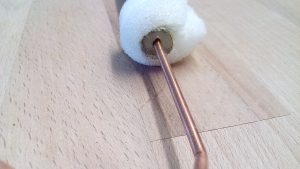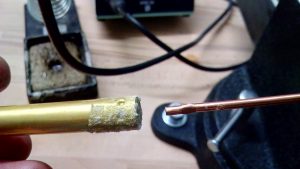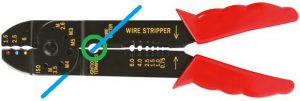 |
This short article describes how I shortened my X50N in order to get a better reception on 446MHz.
This antenna was bought from Wimo’s website, so I’ll consider it as an genuine antenna from Diamond (not one of its numerous and probably bad clones). |
I’ve made a quick and dirty drawing with the original dimensions, which is available here: NoticeAvecCotesX50N.pdf (see page 4, all measurements in mm, lengths and diameters).
I’ll take some time to make something clean with personal notes translated into english later.
15mm were cut off both ends of the copper wire, and 7.5mm off the same copper wire that goes inside the brass tube.
The 15mm cuts could obviously be done, but the 7.5mm cuts required more work. Let’s take a look at the picture below:
Once the foam is removed, you can see the white plastic cylinder inside the brass tube, with the copper wire fit together. The brass tube is stamped many times on the plastic cylinder, so you can just forget about dissociating these two elements properly.
Before getting the copper wire off the plastic cylinder, mark it with a permanent pen or a cutter blade stroke at the intersection of both elements.
The solution I chose consisted in holding the copper wire with a bench vice, with the brass tube quite close to its edge, and using a low cost Faston crimping tool as a lever to pull the brass tube. See the picture below for more details about how to use it as a lever:
The crimping tool is placed between the bench vice’s edge and the brass tube, with the copper wire (blue line) going through it (green circle).
Once the copper wire decides to pop off the plastic cylinder, measure the length of the copper wire that was held inside the plastic cylinder and mark it again on the copper wire, cut 7.5mm off this end of the copper wire, then put it back until the second mark reaches the edge of the the plastic cylinder.
Repeat this process on the other side of the brass tube.
Put the white foam back with some additional glue if needed, then reassemble the antenna inside the fiberglass tube.
Below the measurements I made with my VNA
VHF band before modification X50N_VHF.pdf / after modification X50N_VHF_2nd_cut_-_on_the_mast.pdf
UHF band before modification X50N_UHF.pdf / after modification X50N_UHF_2nd_cut_-_on_the_mast.pdf
Even though real conditions tests give good results, there might be better ways to change its center frequency.
Feel free to comment, to provide actual X50NA dimensions or any relevant information about how to modify the X50N.
Please note that this modification is useless on the X50NA, which already has its UHF bandwidth centered close to 446MHz.



Bonjour, sur le schéma manuscrits vous ne faites pas mention des endroits où vous effectuez les coupes ? Avez vous un schéma plus explicite ou de nouveaux réglages à apporter, d’avance merci ? 73 to France
Bonjour,
Les 15mm sont coupés aux extrémités haute et basse de l’antenne. Les 7.5mm sont coupés sur les tiges en cuivre qui rentrent de chaque côté du tube en laiton.
Ceci étant dit, même si le ROS retombe sur la partie UHF haute, cela ne garantit pas un rayonnement optimal. Une charge non rayonnante offre un ROS très faible, mais comme son nom l’indique, elle n’est pas faite pour rayonner le signal qui lui est appliqué. Cette modification a permis une utilisation en bande haute UHF, avec des émissions qui étaient relativement proches. Depuis, j’ai remplacé cette antenne par une X300, utilisée sans modification un peu plus bas en fréquence 😉
D’accord merci,je vais voir avec mon technicien, si c’est assez clair pour lui. N’hésitez pas à refaire un schéma si possible, Vous êtes le seul à avoir fait un article sur cette modification, et étant donné que la X50NA n’est sont plus disponible pour l’instant en France… Encore merci